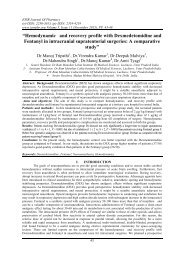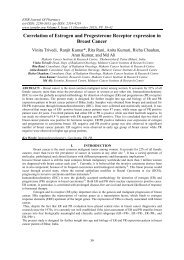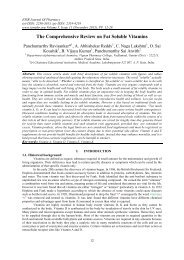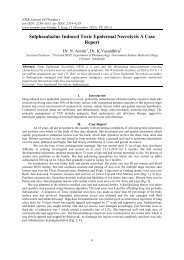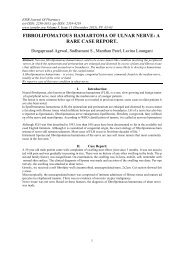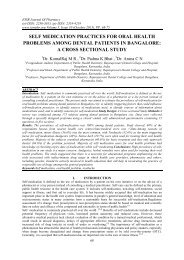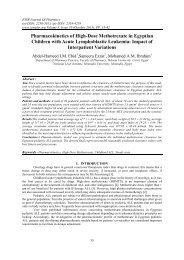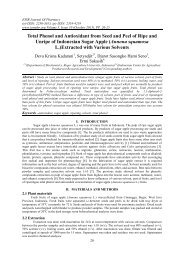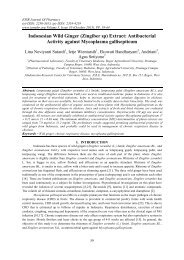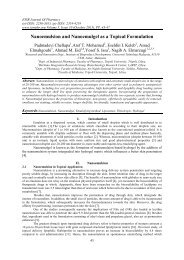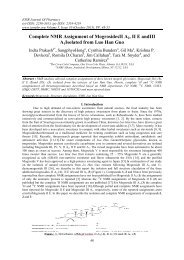C03011019026.pdf
IOSR Journal of Pharmacy (IOSRPHR) The IOSR Journal of Pharmacy (IOSRPHR) is an open access online
IOSR Journal of Pharmacy (IOSRPHR)
The IOSR Journal of Pharmacy (IOSRPHR) is an open access online
Create successful ePaper yourself
Turn your PDF publications into a flip-book with our unique Google optimized e-Paper software.
IOSR Journal Of Pharmacy<br />
(e)-ISSN: 2250-3013, (p)-ISSN: 2319-4219<br />
Www.Iosrphr.Org Volume 3, Issue 11 (December 2013), Pp 19-26<br />
The Effectiveness of Long Acting Amide Local Anesthetics In<br />
Surgical Removal of Lower 3 rd Molars – A Systematic Review.<br />
Dr. Muhammed Anvar Sadath B.D.S, (M.D.S) 1 ,Prof.Dr.Ashok.K.Ramadorai.<br />
FDRCS(Edin),FFRCS(Ire) 2. Dr. Avinash Reddy. M.D.S 3 ,<br />
Prof.Dr. M.R.Muthusekhar, M.D.S. ,Dr. James Solomon Jesudasan, B.D.S,<br />
(M.D.S) 5 .<br />
STRUCTURED ABSTRACT: Background: “Local or regional anaesthesia may be defined as a<br />
regional loss of sensation to a painful stimulus as well as loss of all other sensations including temperature,<br />
pressure and touch etc resulting from a reversible interruption of peripheral conduction along a specific neural<br />
pathway” Malamed 1 .Local anesthetics are chemicals that block nerve conduction in a specific, temporary and<br />
reversible manner, without affecting the patient’s consciousness. The molecule consists of two poles: a<br />
hydrophilic tertiary or secondary amino group and a lipophilic aromatic ring. According to the type of<br />
intermediate alkyl linkage between them, they are classified in ester-type anesthetics, with an amino-ester bond<br />
and whose prototype is procaine, and the amide-type with an amino-amide bond and whose prototype is<br />
lidocaine 2 .The choice of anesthetic solution should be based on three main clinical considerations: anesthetic<br />
potency, latency (time to onset of anesthesia), and duration of the anesthetic effect. 1,3,4,5 . A number of local<br />
anesthetic agents are available that provide rapid onset of surgical anesthesia and adequate duration of<br />
anesthetic effect 6 Vasoconstrictors have been added to local anesthetic solutions to increase the quality and<br />
duration of anesthesia, avoid excessive intraoperative bleeding, and decrease systemic toxicity.<br />
Aim: To evaluate the effectiveness of long acting amide local anesthetics in surgical removal of lower 3 rd<br />
molars.<br />
Materials and Methods:<br />
Search Strategy<br />
Articles were searched in Medline, Pubmed, Mesh, Only English literature articles, human trails and<br />
randomized control trails were searched for.<br />
Selection criteria<br />
Only those articles were selected which used long acting amide local anesthetics for surgical removal of<br />
mandibular 3 rd molars. Randomized control trails and Human trails were selected.<br />
Data Collection and analysis<br />
Data was searched independently and in duplicate. The Primary out come was on set of anesthesia and<br />
Duration of anesthesia after giving long acting amide local anesthetics in surgical removal of mandibular 3 rd<br />
molars in experimental group in parallel design studies. Analyses were undertaken for the item assessed for<br />
quality and publication bias..<br />
Results: The Primary outcome of the review is to assess the onset of action and Duration of action of long<br />
acting amide local anaesthetics in surgical removal of mandibular 3 rd molars Four trails provided data for this<br />
review none of the studies full fill all the methodological quality assessment criteria.<br />
Conclusion: The data shows amide local anaesthetics provide satisfactory onset of action and longer<br />
duration of action during the surgical removal of mandibular 3 rd molars. (include drawback)<br />
I. INTRODUCTION<br />
Local anaesthetics are drugs that have little or no irritating effect when injected into the tissue that will<br />
temporally interrupt conduction when absorbed into the nerve. A blockade of all afferent nerve transmission<br />
produces anaesthesia or a lack of all sensation. Blockage of those fibers transmitting pain sensation only result<br />
in regional analgesia. Interruption of efferent fibers result in motor paralysis and on inhibition of astronomically<br />
innervated structures. 1<br />
Basic molecular structure of local anesthetics.<br />
19
The Effectiveness of Long Acting Amide Local Anesthetics In...<br />
Local anaesthetics generally have a lipid-soluble hydrophobic aromatic group and a charged,<br />
hydrophilic amide group. The bond between these two groups determines the class of the drug, and may be<br />
amide or ester. Examples of amides include lignocaine, bupivacaine and prilocaine. Examples of esters include<br />
cocaine and amethocaine 7 .<br />
Aromatic Group – Intermediate chain –Amino group<br />
(lipophilic) (Ester Amide linkage) (Sec or Ter. Amine)<br />
The clinically useful LAs are week bases with amphiphillic property. A hydrophilic secondary or<br />
tertiary amine on one side and a lipophilc aromatic residue on the other are joint by a alkyl chains through ester<br />
or Amide linkage. Ester linked LAs are cocaine, procaine, chloroprocaine, tetracarne, benzocaine. Amide linked<br />
LAs are lidocaine, bupivacaine, levobupivacane Etidocarne, Articarne, Mepivacaine, Prilocarne, Ropivacaine.<br />
Local anesthetics vary in their potency, allowing for concentrations that range typically from 0.5 to 4%. This is<br />
largely the result of differences in lipid solubility, which enhances diffusion through nerve sheaths and neural<br />
membranes. This property is determined by the aromatic ring and its substitutions, along with those added to the<br />
tertiary amine. For example, bupivacaine is more lipid soluble and potent than articaine, allowing it to be<br />
formulated as a 0.5% concentration (5 mg/mL) rather than a 4% concentration (40 mg/mL). 8 .<br />
Pain is most commonly experienced symptom during Extraction. Basic to the understanding of Pain, as<br />
well as its elimination through the use of local anesthetics, is the understanding of nerve conduction the self<br />
propagated passage of an electrical current along nerve fibers. The conduction of an impulse by a nerve depends<br />
on the electrical potential that exists across the nerve membrane. Although an electrical potential exists across<br />
the membrane of most of cells in the body. The nerve cells, being excitable, possesses the ability of transmitting<br />
or conducting impulse along its length. The phenomenon is brought about by the flow of current across the<br />
membrane during the transition of the nerve from the resting to the active state. 1 . The use of local anesthetics<br />
(LAs) in dentistry and other surgical procedures as a means of pain control has been one of the medical marvels<br />
of twentieth century 9,10<br />
Basic physiology of nerve conduction<br />
An electrophysiologic theory to explain the mechanism of conduction was proposed by Hodgkin and<br />
Huxley 1952 .According to their concept, the nerve cell lies in an environment of body water and the major<br />
extra cellular cation in this water is sodium. The major intracellular cation on is potassium. At rest the ratio of<br />
potassium inside the nerve cell to those outside the nerve cell is approximately 30:1 Hence there is a difference<br />
of electrical potential. Based on the ratio. The potential across the nerve cell membrane is -50 to -70 millivolts.<br />
This is called resting membrane potential (RMP)<br />
RMP = [K+] in = -70 mV<br />
[K+1]out<br />
On the basis of this distribution of icons, the outside of the nerve cell membrane has a positive charge where as<br />
inside her a negative charge.<br />
The nerve cell membrane is a porous structure the calcium ion act as a gate in its pores. At rest<br />
position, the gate is closed and hence impermeable to sodium and potassium ions when nerve is excited to<br />
threshold level, the calcium ions are displaced from there pores. The gate opens and the sodium ions rush into<br />
the nerve cell. The trans membrane potential is altered and there is reversal of polarity is called depolarization.<br />
This change is propagated along the nerve cell membrane. Repolarization follows maximum depolarization.<br />
Following maximum depolarization. The permeability to sodium ions decreases and an increase in permeability<br />
to potassium ions with diffusion of potassium ions to the outside takes place. The trans membrane potential is<br />
restored to -70 millivotts. Calcium ions returns to the pores in the cell membrane. Finally, potassium ion is<br />
actively transported into the cell and sodium is actively transported out of the cell to return there ions into their<br />
original concentration 1,9,<br />
Mechanism of action of local anesthetic:<br />
The local anesthetic are acidic salts of week base. They combine with strong acids like HCL to make<br />
soluble acidic salt. This soluble acidic salts dissociates the base environment found in the tissues. At normal<br />
tissue PH there is more and more dissociation yielding more nonioinized lipophilic molecule, This molecule<br />
diffuse readily through the nerve sheath composed of lipidis, Here it combines with H+ forming ionized<br />
hydrophilic molecule, this ionised hydrophilic molecule displacing the calcium gate and cause stopping the<br />
sodium inflex. Sodium inflex is stopped means conduction of impulse is stopped 1,9 .<br />
Anaesthetic technique used during surgical removal of mandibular third molar:<br />
20
The Effectiveness of Long Acting Amide Local Anesthetics In...<br />
Mandibular 3 rd molar are supplied by inferior alveolar nerve, mucous membrane on the lingual side of<br />
the mandible is supplied by lingual nerve. Mandibular buccal mucosa in relation to 3 rd molar are supplied by<br />
long buccal nerve so while doing surgical removal of lower 3 rd molar. All these 3 nerves has to be<br />
anaesthetised. Usually the inferior. Alveolar nerve is anaesthetised by classical inferior alveolar nerve block,<br />
lingual nerve is anaesthetised by lingual nerve block long buccal nerve is anaesthetize by Buccal nerve<br />
block. 9,10,11 S T R U C T U R E D Q U E S T I O N<br />
Are amide local anesthetics more effective in surgical removal of mandibular 3 rd molars ?<br />
M A T E R I A L S A N D M E T H O D<br />
Search source and Methodology:-<br />
A systematic literature search was done in accordance with the Cochrane guidelines. The search was<br />
done in pubmed and mesh for the related topic with no time limit until first week of July 2012. The article<br />
search included only those listed in English literature. Articles were also hand searched from journals.<br />
- Journal of oral and maxillofacial surgery<br />
- International journal of oral and maxillofacial surgery<br />
- British journal of oral and maxillofacial surgery<br />
P I C O A N A L Y S I S<br />
Study Population:<br />
The study population was based on patients with mandibular 3 rd molars indicated for surgical removal.<br />
Type of intervention:<br />
Studies using long acting amide local anesthetics for surgical removal of mandibular 3 rd moars.<br />
Type of comparison:<br />
Studies in which one long acting amide group is compared with short acting or intermediate acting group or<br />
with another group of local anesthetics.<br />
Type of outcome measures:<br />
Onset of action of local anesthetics and duration action of local anesthetics.<br />
INCLUSION CRITERIA:<br />
The title of the articles and the abstracts were reviewed. Articles using long acting amide local anesthetics in<br />
surgical removal of mandibular 3 rd molars were included for further review. The selection criteria was as<br />
follows: Randomised controal trails were selected. Only human trials were taken into consideration.<br />
EXCLUSION CRITERIA:<br />
Articles which are Case reports and case series, letters, reviews, animal study and in -<br />
vitro studies and literature in othe r languages were excluded.<br />
RESULTS<br />
TABLE 5: LIIST OF INCLUDED ARTICLES IN THE SYSTEMATIC REVIE W<br />
S L NO AU THOR AND JOUR N AL N AME OF THE AR T IC LE<br />
1<br />
Leonardo V.L.Gregorio et al<br />
Oral Surg Oral Med Oral Pathol Oral Radiol Endod 2008;<br />
106: 19-28<br />
.<br />
A Comparison of the clinical anesthetic efficacy of 4 % articaine and<br />
0.5 % bupivacaine (both with 1: 200,000 epinephrine) for lower third<br />
molar removal<br />
2<br />
Alejandro Sierra Rebolledo, Esther Delgado Molina,<br />
Leonardo Berini Ates, Cosme Gay Escoda.<br />
Med Oral Potol Oral Cir Bucal 2007; 12: e 139-44.<br />
Comparative study of the anesthetic efficacy of 4% articaine versus<br />
2% lidocaine in inferior alveolar nerve block during the surgical<br />
extraction of impacted lower third molar.<br />
3<br />
4<br />
Carlos F Santos et al.<br />
JOMS 65:2445-2452, 2007<br />
Anna Trullenque- Eriksson, Blanca Guisado – Moya<br />
Med Oral Patol Oral Cir Bucal 2011 May 1;16(3) : e390-6<br />
Epinephrine concentration 1: 100,0000 or 1: 200,000 doesnot affect<br />
the clinical efficacy of 4 % articaine for lower third molar removal:<br />
A double blind randomised control Trial<br />
Comparative study of two local anesthetics in the surgical extraction<br />
of mandibular third molars : Bupivacaine and Articaine<br />
21
TABLE 6: DESCRIPTION OF INCLUDED ARTICLES<br />
22
TABLE 7: SUMMATION OF RESULTS<br />
FIGURE 3: CHART SHOWING THE ONSET OF ACTION AND DURATION OF ACTION<br />
OF THEAMIDE LOCAL<br />
ANESTHETICS DESCRIPED IN THE ARTICLES OBTAINED BY THE SYSTEMATIC<br />
SEARCH<br />
23
QUALITY ANALYSIS:<br />
Once a final conclusion was attained regarding the articles to be reviewed, data were extracted from<br />
each article were tabulated. This was later cross checked. A quality assessment of the studies was made as<br />
follows.<br />
The quality assessment of included trails was undertaken independently as a part of data extraction<br />
process. Four main quality criteria were examined.<br />
1. Method of Randomisation, recorded as,<br />
(a) Yes – Adequate as described in the text<br />
(b) No - Inadequate as described in the text<br />
(c) unclear in the text.<br />
2. Allocation concealment, recorded as<br />
(a) Yes – Adequate as described in the text<br />
(b) No Inadequate as described in the text<br />
(c) unclear in the text.<br />
3. Outcomes assessors blinded to intervention, recorded as<br />
(a) Yes – Adequate as described in the text<br />
(b) No Inadequate as described in the text<br />
(c) unclear in the text.<br />
RISK OF BIAS IN INCLUDED STUDIES:<br />
The assessment for four main methodological quality items are shown in the table. The study was assessed to<br />
have a” high risk of bias” if it didnot record a “Yes” in three or more of the four main categories, “Moderate”<br />
If two out of four categories did not record a” Yes” and “Low” if randomisation assessor blinding and<br />
completness of follow up were considered adequate.<br />
TABLE 8: RISK OF BIAS<br />
STUDY RANDOMIZATION ALLOCATION<br />
CONCEALED<br />
ASSESOR<br />
BLINDING<br />
DROPOUTS<br />
DESCRIBED<br />
RISK OF<br />
BIAS<br />
Anna Trullenque-<br />
Eriksson etal Yes Yes Unclear None Moderate<br />
2011<br />
Leonardo V.L<br />
Gregorio et al Yes Yes Yes None Low<br />
2008<br />
Alejandro Sierra<br />
Rebolledo et al Yes Yes Yes None Low<br />
2007<br />
Carlos F Santos<br />
etal<br />
2007<br />
Yes Yes Yes None Low<br />
Report on quality of evidence looked upon:<br />
Most of the articles included in this systematic review are of high quality based up on a score of “low”<br />
for risk of bias. Moreover, all studies included are randomized clinical trials with high level of evidence of score<br />
“2”. Hence, the interpretations obtained from these studies are proposed to be reliable.<br />
Report on outlier data: No outlier data obtained.<br />
DISCUSSION<br />
Ideal tooth extraction is a painless removal of whole tooth or tooth root with minimal trauma to the<br />
investing tissues so that the wound heals uneventfully and no post-operative prosthetic problem is created. The<br />
painless removal of tooth extraction requires local anaesthesia. The local or regional anaesthesia may be defined<br />
as ‘regional loss of sensation to a painless stimulus as well as loss of all other sensation including temperature ,<br />
pressure, touch etc resulting from a reversible interruption of peripheral conduction along a specific neural<br />
pathway towards the brain’ 1,9,12 . Ascribing local anesthetic potency is an attempt to define the sensitivity of<br />
nerves to different local anesthetics and to estimate anesthetic requirements during regional anesthesia. The<br />
potency of local anesthetics increases parallel with increasing lipid solubility. The binding ability of local<br />
anesthetics to the phospholipid membrane as a result of physicochemical features and in vivo interaction has also<br />
been found to be directly in parallel with the potency.<br />
24
In clinical practice, other factors affect the potency of a local anesthetic, including:<br />
hydrogen ion balance<br />
fiber size, type, and myelination<br />
vasodilator/vasoconstrictor properties (affects rate of vascular uptake)<br />
frequency of nerve stimulation<br />
ambient pH (lower pH results in greater ionisation and a reduction in efficacy)<br />
electrolyte concentrations (hypokalemia and hypercalcemia antagonizes blockade) 12,13<br />
Extractions can be intraalveolar or transalveolar(surgical) . The benefits of surgical extraction are - less chances of<br />
damage to neurovascular bundles , fracture of bone is avoided , less chances of soft tissue tear, less chances of fracture of<br />
large piece of alveolar bone . The indication for surgical extraction are any tooth that resists extraction by closed method ,<br />
unerupted or impacted tooth which cannot be removed by closed method , fracture of tooth or root below the level of<br />
epithelial attachment , teeth with hypercementosis of roots , tooth with fused , dilacerated , or locked roots and ankylosed<br />
roots specially in elderly persons 15,17 .<br />
In this review four articles meeting the selection criteria, were selected and assessed. Anna Trullenque-Eriksson,<br />
Blanca Guisado Moya 15 , compared 0.5 % bupivacaine and 4 % articaine both with 1:200000 epinephrine. It is a randomized<br />
crossover study . This study involves 35 patients having bilaterally symmetrical mandibular third molars . The outcome<br />
measures evaluated are onset of anaesthesia , duration of residual analgesia , duration of soft tissue anaesthesia. This study<br />
shows no statistically significant difference for onset of anaesthesia, (inferior alveolar nerve , Bupivacaine 3.68 + 3.11 min<br />
and articaine 2.81 + 1.92 min ; buccal nerve bupacaine 1.95+ 1.25 min articaine 1.63+1.14 min ) , the duration of residual<br />
analgesia (bupivacaine 5.11+4.45 hours and articaine 4.61+3.77 hours). Statistically significant difference were found<br />
between the duration of soft tissue anaesthesia . This is 8.20 +4.54 hours in case of bupivacaine , 5.32+2.16 hours in case of<br />
articaine . Post operative pain was significantly lower at 6 and 12 hours in procedures performed with articaine . In addition<br />
to this it was found that there was a correlation between pain and surgical time for bupivacaine at 6, 12 , 24 , 48 hours. Patient<br />
prefer articaine 63.2% ; 26.3% bupivacaine; 10.5 % neither . The reason for patients preference to articaine than bupivacaine<br />
is that articaine is least painful but bupivacaine produce more post operative pain and swelling. This article concluded that<br />
articaine is more suitable local anaesthetic for extraction of lower molars due to shorter duration of anaesthetic effect in the<br />
soft tissue , lower pain complaint by patient during immediate post operative period.<br />
Carin C.S Madene , Fernando P.M. Giglio et al 18 compare 4% articaine with 1:100000 epinephrine with 4%<br />
articaine with 1:200000 epinephrine on mandibular third molar extraction . It is a double blind randomized crossover study .<br />
IN this study 50 patients underwent extraction of symmetrically positioned mandibular third molars in two separate<br />
appointments. The outcome measures in this study are latency , duration of post operative analgesia , duration of anaesthetic<br />
action on soft tissue , intra operative bleeding and haemodynamic parameters were evaluated. This study shows both the<br />
drugs have similar latency( 1.64+0.08 and 1.58 +0.08 respectively ; p>0.05) ; both the drugs shows similar duration of action<br />
on soft tissues ( around 250 min ; p>0.05) . Both the drugs shows similar duration of post operative analgesia (around 200<br />
min ;P>0.05) . Intraoperative bleeding was minimal in both the drugs. Transient changes in haemodynamic changes were<br />
observed but they are not clinically significant . So author concluded that an epinephrine conc of 1:100000 or 1:200000 in 4%<br />
articaine solution does not affect the clinical efficacy of this local anaesthetic , so it is better to use 4% articaine with lower<br />
concentration of epinephrine(1:200000) for mandibular third molar extraction with or without bone removal .<br />
Alejandro Sierra Rebolledo 19 , Esther Delgado Moena et al did a comparative study of anaesthetic efficiency of 4%<br />
articaine Vs 2% lidocaine inferior alveolar nerve block during surgical extraction of impacted lower third molar . Both the<br />
anaesthetic agents with 1:100000 concentration of epinephrine were used . this study is a randomized double blind clinical<br />
trial done on 30 patients with bilaterally symmetrical surgical extraction of mandibular third molars . The outcome measures<br />
evaluated are onset of action, duration of anaesthetic effect , the amount of anaesthetics used, intraoperative pain usin VAS<br />
scale. In this study a statistiscally significant difference is observed in the duration anaesthetic effect (220.68 min , 4%<br />
articaine and 168.20 min for 2% lidocaine ).The onset of action is 7.0 seconds in lidocaine and 56.0 seconds in articaine is not<br />
statistically significant . Intraoperative pain using VAS is 12,8 in lignocaine and 13.8 in articaine are also statistically<br />
significant. In this study the author concluded that 4% articaine offers better clinical performance than 2% lidocaine specially<br />
in terms of onset of action, duration of anaesthetic effect. However no statistically significant difference were recorded in<br />
anaesthetic efficacy of two solutions.<br />
Leonardo V.L. Gregorio et al 20 did a comparative study of clinical anaesthetic efficacy of 4 % articaine and 0.5 %<br />
bupivaicaine both with 1:200000 epinephrine for lower third molar removal . this study included 50 patients with<br />
symmetrically positioned lower third molars in a double blind , randomised cross over manner. The outcome measures<br />
evaluated are onset of anaesthesia, duration of post operative analgesia, duration of anaesthetic action on soft tissue ,<br />
intraoperative bleeding, and haemodynamic parameters . In this study statistically significant differences between the onset of<br />
anesthesia of 4 % articaine (1.66+0.13 min) and 0.5 % bupivacaine (2.51+0.21 min) p0.05) . The patient who were anaesthetised by 0.5%<br />
bupivacaine experienced a statistically significant longer period of anaesthesia(5 hours) on soft tissue when compared with<br />
patient who received 4 % articaine (4 hours), p
CONCLUSION<br />
Amide local anesthetics are more effective in surgical removal of mandibular third molars due to their<br />
longer duration of action, comparatively faster onset of action and they rarely cause hypersensitivity reactions.<br />
SUMMARY<br />
To summarise, this structured review was done to find out how effective is amide long acting local<br />
anesthetic in the surgical removal of mandibular third molars. A systematic screening of the NCBI Pubmed,<br />
Pubmed Central, Mesh and Cochrane databases were carried out for relevant articles. In addition hand searches<br />
were also carried out. Results of the studies indicate that long acting amide local anesthetics are very effective in<br />
case of surgical extraction of mandibular third molars except the fact that Bupivacaine in some patients causes<br />
more post operative pain and swelling.<br />
REFERENCES<br />
[1] Malamed SF. HandBook of Local Anesthesia. 4th ed. St Louis: CV Mosby; 1997.<br />
[2] Milam SB, Giovannitti JA Jr. Local anesthetics in dental practice. Dent Clin North Am. 1984;28:493-508.<br />
[3] Berini-Aytés L, Gay-Escoda C. Anestesia Odontológica. 2nd ed. Madrid: Ediciones Avances Medico-Dentales, S.L.; 2000.<br />
[4] Mehra P, Caiazzo A, Maloney P. Lidocaine toxicity.<br />
[5] Anesth Prog 1998;45:38-41.<br />
[6] Daublander M, Muller R, Lipp MD. The incidence of complications associated with local anesthesia in dentistry. Anesth Prog<br />
1997;44:132-41.<br />
[7] Hawkins JM, Moore PA: Local anesthesia: Advances in agents<br />
[8] and techniques. Dent Clin North Am 46:719, 2002<br />
[9] Local Anaesthetic Pharmacology .Dr Hilary Edgcombe, Dr Graham Hocking<br />
John Radcliffe Hospital, Oxford, UK<br />
[10] Local Anesthetics: Review of Pharmacological Considerations<br />
[11] Daniel E Becker, DDS * and Kenneth L Reed, DMD † Anesth Prog. 2012 Summer; 59(2): 90–102. doi: 10.2344/0003-3006-<br />
59.2.90<br />
[12] Malamed SF. Handbook of Local Anesthesia. 5th edition. Mosby Inc.; 2004.<br />
[13] Evers H, Haegerstam G. Introduction to Dental Local Anesthesia. 2nd ed. St Louis: The CV Mosby Co;; 1990.<br />
[14] Watson JE. Appendix: some anatomic aspects of the Gow-Gates technique for mandibular anesthesia. Oral Surg Oral Med Oral<br />
Pathol. 1973;36:328–330. [PubMed]<br />
[15] Gupta PP, Mishra YC, Dhawan BN. Comparision of Centbucridine and Lignocaine in dental surgery.International Journal of<br />
Obstetric Anesthesia. 1989;37(3):106–111.<br />
[16] Kokubu M, Oda K, Kudo M, Machida M, Shinya N. Correlation between the anesthetic potency of local anesthetics and their<br />
binding ability to a model membrane. J Anesth. 1979;11:121–125.<br />
[17] Articaine: a review of its use for local and regional anesthesia Marc SnoeckDepartment of Anaesthesia, Canisius-Wilhelmina<br />
Hospital, Nijmegen, The Netherlands.Correspondence: M Snoeck, Department of Anaesthesia C40-01, Canisius-Wilhelmina<br />
Hospital, Weg door Jonkerbos 100, 6532 SZ Nijmegen, Local Reg Anesth. 2012; 5: 23–33.Published online 2012 June<br />
5. doi: 10.2147/LRA.S16682.<br />
[18] Cowan A. Clinical assessment of a new local anesthetic agent – carticaine. Oral Surg Oral Med Oral Pathol. 1977;43:174–<br />
180. [PubMed]<br />
[19] Yapp KE, Hopcraft MS, Parashos P. Articaine: a review of the literature. Br Dent J. 2011;210:323–329. [PubMed]<br />
[20] Comparative study of two local anesthetics in the surgical extractionof mandibular third molars: Bupivacaine and articaine<br />
[21] Anna Trullenque-Eriksson 1, Blanca Guisado-Moya 2 1 Bachelor of Dentistry. Master in Dentistry Science. Universidad<br />
Complutense de Madrid,2 Professor of Oral Surgery, Department of Oral and Facial Medicine and Surgery. Faculty of Dentistry.<br />
Universidad Complutense de Madrid Med Oral Patol Oral Cir Bucal. 2011 May 1;16 (3):e390-6.<br />
[22] 18. Epinephrine Concentration (1:100,000 or 1:200,000) Does Not Affect the Clinical Efficacy of 4% Articaine for Lower Third<br />
Molar Removal: A Double-Blind, Randomized, Crossover Study<br />
[23] Carlos F. Santos, DDS, PhD,* Karin C.S. Modena, DDS,†<br />
[24] Fernando P.M. Giglio, DDS, MSc,‡ Vivien T. Sakai, DDS, MSc,§<br />
[25] 2007 American Association of Oral and Maxillofacial Surgeons<br />
[26] 0278-2391/07/6512-0008$32.00/0 doi:10.1016/j.joms.2007.04.020<br />
[27] Comparative study of the anesthetic efficacy of 4% articaine versus 2% lidocaine in inferior alveolar nerve block during surgical<br />
extraction<br />
[28] of impacted lower third molars .Alejandro Sierra Rebolledo 1, Esther Delgado Molina 2, Leonardo Berini Aytés 3, Cosme Gay<br />
Escoda 4 Med Oral Patol Oral Cir Bucal 2007;12:E139-44.<br />
[29] A comparison of the clinical anesthetic efficacy of 4% articaine and 0.5% bupivacaine (both with 1:200,000epinephrine)<br />
for lower third molar removal.<br />
[30] Gregorio LV, Giglio FP, Sakai VT, Modena KC, Colombini BL, Calvo AM, Sipert CR, Dionísio TJ, Lauris JR, Faria<br />
FA, Trindade Junior AS, Santos CF.<br />
[31] Source.Bauru School of Dentistry, University of São Paulo, Brazil.<br />
[32] Oral Surg Oral Med Oral Pathol Oral Radiol Endod. 2008 Jul;106(1):19-28. doi: 10.1016/j.tripleo.2007.11.024. Epub 2008 Apr<br />
16.<br />
26




